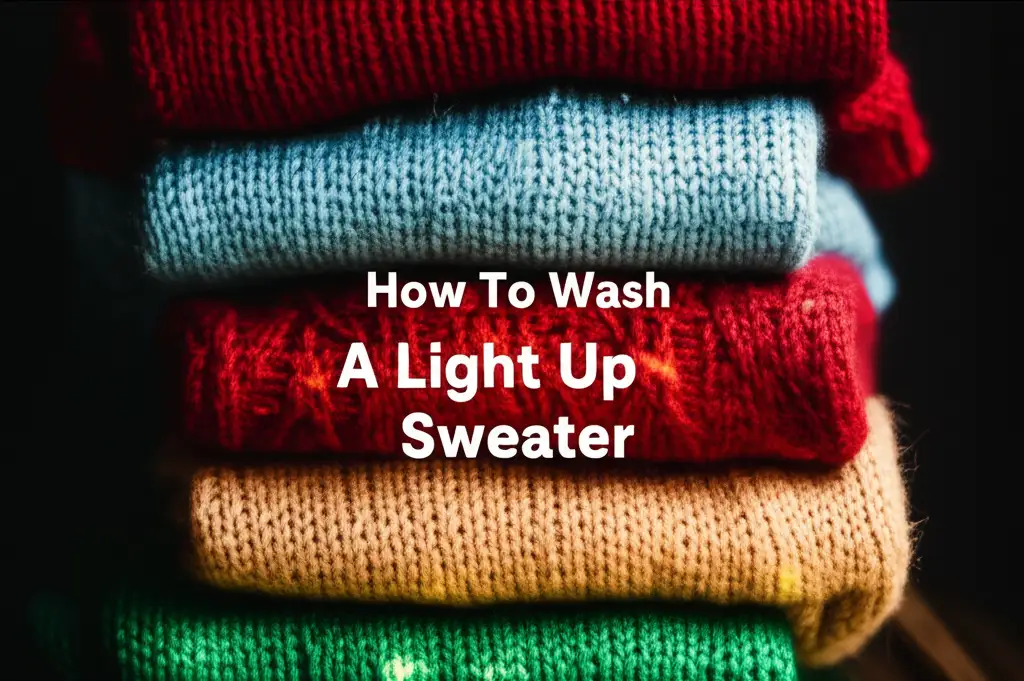· Clothing Care · 17 min read
How To Wash A Light Up Sweater

Washing a Light Up Sweater Safely
Having a light-up sweater is fun. These garments add sparkle to any event. Yet, when it comes to cleaning, they present a unique challenge. You cannot simply toss them into a washing machine like a regular shirt. The integrated electronics require special care. Learning how to wash a light up sweater correctly helps you keep it glowing brightly.
This guide provides simple, clear steps. We will cover everything from initial checks to proper drying and storage. My goal is to help you maintain your festive apparel for many seasons. I want to make sure your glowing garment remains a star attraction. Follow along to master the art of cleaning these special items.
Takeaway
To wash a light up sweater safely:
- Always remove all electronic components and batteries first.
- Spot clean or hand wash the sweater gently with cold water and mild detergent.
- Never use a washing machine or dryer unless the tag explicitly allows it and components are removable.
- Air dry flat on a clean towel, away from direct heat or sunlight.
- Store properly to prevent damage to the fabric or wiring.
The best way to wash a light up sweater is by hand, after carefully removing all electronic components and batteries. Use cold water and a mild detergent for spot cleaning or gentle soaking. Air dry the sweater flat to preserve its shape and protect any remaining wiring or delicate embellishments.
Understanding Your Light Up Sweater’s Design
Every light-up sweater is unique. Before you start to wash a light up sweater, you must understand its specific construction. Manufacturers use different types of lights and battery packs. Some sweaters have removable LED strings and battery boxes. Others have these components permanently sewn into the fabric. Knowing the design helps you choose the right cleaning method.
Check the care label inside the sweater. This label provides crucial information about washing, drying, and ironing. It often indicates if parts are removable or if the sweater is hand-wash only. Ignore this label at your own risk. Following its instructions is your first line of defense against damage.
Look closely at the lights and wires. Are they easily detached? Can you unclip a battery pack? Some designs allow you to take out the entire electronic system. This makes washing much simpler. If parts are fixed, you must be extra careful during cleaning. These fixed components mean you must avoid submersion or harsh scrubbing.
The fabric type also matters. Light-up sweaters often use acrylic, wool blends, or cotton. These materials react differently to water and detergents. Wool might shrink with hot water. Acrylic can lose its shape if dried improperly. Understanding the fabric helps you choose the right water temperature and drying method. Consider the delicate nature of the wires and circuits integrated into the fabric. Always treat these areas with extreme care to avoid damage.
I have seen many light-up sweaters ruined by improper washing. My advice is always to proceed with caution. Treat your sweater like a delicate piece of art. This approach helps preserve its unique features and extends its life. A little time spent understanding your sweater pays off in the long run.
Essential Preparations Before Washing
Proper preparation is the most important step before you wash a light up sweater. Skipping this stage can damage your garment permanently. Your primary goal is to protect the electronic components from water. Water and electronics do not mix well. Take your time with these initial steps.
First, locate and remove all batteries. Most light-up sweaters have small battery packs hidden in pockets or sewn-in pouches. These packs are usually secured with Velcro or a zipper. Open the pouch carefully and take out every battery. Some sweaters might have more than one battery compartment. Double-check all areas to ensure no batteries remain inside.
Next, identify if the entire lighting system is removable. Some advanced sweaters have modular LED strips that plug into a central unit. You can detach these strips from the fabric. If your sweater allows this, remove all lights and wires. Store them safely in a dry place. This step makes washing the fabric much easier and safer.
If the lights are not removable, you must isolate them. Use small plastic bags and rubber bands to cover any fixed battery packs or control boxes. Seal them tightly to prevent water from entering. Some people use cling film for extra protection. This creates a waterproof barrier around the sensitive parts. Remember, even a small amount of moisture can cause a short circuit or corrosion.
Pre-treat any visible stains before washing the whole sweater. Use a mild stain remover designed for delicate fabrics. Apply it directly to the stain with a soft cloth. Gently blot the area; do not rub aggressively. This helps lift dirt without spreading it or damaging the fabric. Pre-treating prevents stains from setting during the main wash. For example, if you have a delicate hat, you might spot clean it before a full wash. This method is similar for sweaters.
Always test stain removers on an inconspicuous area first. This ensures the product does not discolor or damage the fabric. I always do this myself to avoid surprises. Careful preparation sets the stage for a successful wash.
Hand Washing Your Light Up Sweater
Hand washing is generally the safest and most recommended method when you wash a light up sweater. This method gives you complete control over the process. It minimizes stress on the delicate electronic components and fabric. I always prefer hand washing for special items like this. It helps preserve their integrity for a longer time.
Start by filling a clean basin or sink with cool water. Cold water is best for delicate fabrics and helps prevent colors from bleeding. Using a bathtub also works if your sweater is large. Ensure the basin is spotless before adding water. Dirt or residue can transfer to your sweater.
Add a small amount of mild liquid detergent to the water. Choose a detergent formulated for delicate items. Avoid harsh chemicals, bleach, or strong stain removers. These can damage the fabric fibers or the integrated wiring. Gently swirl the water to mix in the detergent. You want a light, soapy solution, not a tub full of suds. Remember, too much detergent can be hard to rinse out.
Submerge the sweater into the soapy water. Gently press it down to ensure it is fully saturated. Do not twist, wring, or stretch the fabric. This can damage the internal wiring or deform the sweater’s shape. Focus on gently squeezing the water through the fabric. Pay extra attention to any soiled areas, but avoid rubbing directly over the electronic parts.
Let the sweater soak for about 10-15 minutes. This allows the detergent to break down dirt and odors. For very dirty sweaters, you might extend the soak time slightly. However, do not leave it soaking for hours. Prolonged soaking can loosen adhesives or harm the fabric.
Rinse the sweater thoroughly under cool, running water. You can also drain the basin and refill it with clean, cool water. Continue rinsing until all soap residue is gone. Squeeze excess water out gently, supporting the sweater’s weight. Do not wring or twist. Handle it like a delicate piece of art. For more tips on delicate handwashing, consider how you might wash a wig without wig shampoo, as the principles of gentle handling are very similar. Learn more about gentle cleaning without harsh chemicals. I always make sure the water runs clear. This ensures no detergent remains to irritate skin or attract dirt later.
Machine Washing a Light Up Sweater: When and How
Machine washing a light up sweater is rarely recommended. It poses significant risks to the electronic components and the fabric. However, some newer light-up sweaters claim to be machine-washable. This is only true if the manufacturer explicitly states it on the care label. Even then, extreme caution is necessary. My personal rule is: if in doubt, hand wash.
First, check the care label meticulously. Look for clear instructions allowing machine washing. The label must also confirm that all electronic components are fully removable. If any part of the lighting system is permanently attached, do not machine wash. The agitation of a washing machine can easily damage delicate wires, connections, or light bulbs. It can also dislodge batteries that you thought were secure.
If the label permits machine washing, ensure you have removed all batteries and any other removable electronic parts. Place the sweater inside a mesh laundry bag. This bag provides an extra layer of protection against snagging, stretching, or friction. It helps contain any loose threads or embellishments. A laundry bag is crucial for any delicate item, similar to how you would protect a hat in a washing machine. Discover tips for washing hats in a machine.
Select the gentlest cycle on your washing machine. This is typically the “delicate,” “hand wash,” or “wool” setting. Use cold water only. Hot water can cause shrinking, fading, or damage to synthetic fibers and electronic components. Cold water is safer for both the fabric and any remaining internal elements.
Use a very mild detergent. Liquid detergents dissolve better in cold water than powders. Use the minimum recommended amount. Too much detergent can create excessive suds and leave residue. Avoid fabric softeners or bleach, as they can degrade the fabric or interfere with the electronics.
Load the sweater into the machine alone or with other very delicate items of similar color. Do not overload the machine. An overloaded machine means less gentle agitation and more friction. Start the cycle and stay nearby. Listen for any unusual noises that might indicate a problem. Once the cycle finishes, remove the sweater promptly to prevent creasing or prolonged exposure to moisture.
I never machine wash my own light-up sweaters. The risk of damage is simply too high for me. If you decide to machine wash, do so with extreme caution. Your sweater’s longevity depends on it.
Drying Your Light Up Sweater Properly
Drying a light up sweater requires patience and care. You cannot use a machine dryer. The heat and tumbling action will melt delicate components, shrink the fabric, or damage the wiring. Proper drying prevents mildew, maintains shape, and keeps the lights functional. This step is as important as the washing itself.
First, gently remove as much excess water as possible after washing. Do not wring or twist the sweater. Instead, lay it flat on a clean, dry towel. Roll the sweater and towel together, pressing gently to absorb water. You can also press the sweater between two towels. Repeat with fresh, dry towels until most of the water is absorbed. The goal is to remove drips without distorting the fabric.
Next, find a clean, flat surface for air drying. A drying rack or a clean, dry floor works well. Lay the sweater completely flat on a fresh, dry towel. Reshape the sweater to its original dimensions. Smooth out any wrinkles or bunched areas. Ensure the electronic components, if fixed, are fully exposed to air to dry thoroughly. This flat drying method prevents stretching and maintains the garment’s shape. Hanging a wet light-up sweater can cause it to stretch out of shape, especially if it’s made of a heavy knit or wool.
Place the drying sweater in a well-ventilated area. Good air circulation helps speed up drying and prevents mildew. Avoid direct sunlight or heat sources like radiators. High heat can damage the fabric, fade colors, or harm the electronic circuits. A shaded, breezy spot is ideal.
Allow plenty of time for the sweater to dry completely. This can take anywhere from 24 to 48 hours, or even longer, depending on the sweater’s thickness and humidity levels. Flip the sweater periodically to ensure even drying. Touch the fabric in several spots to check for dampness. Any lingering moisture can lead to mold, mildew, or damage to the internal wiring. I always give my sweaters an extra day to dry just to be sure. A truly dry sweater feels completely light and free of any coolness from lingering dampness.
Once completely dry, reinsert the electronic components and batteries. Test the lights to ensure they still work. This careful drying process helps maintain the sweater’s integrity and extends its life.
Storing Your Light Up Sweater for Longevity
Proper storage is crucial for preserving your light up sweater between wears. Incorrect storage can lead to creasing, stretching, or damage to the electronic components. Taking a few extra steps when putting your sweater away ensures it stays in great condition for the next festive season. You want your special garment to be ready to shine.
First, ensure the sweater is completely dry before storing. Any lingering moisture can lead to mildew, odor, or corrosion of the electronic parts. Even a slight dampness can cause issues over time. I always let my sweaters air out for an extra day after they feel dry, just to be sure. This prevents unexpected musty smells or damage.
Remove all batteries from the sweater before storing it for extended periods. Batteries can leak acid over time, which can damage the battery compartment, corrode wires, and stain the fabric. Store the batteries separately in a cool, dry place. This simple step prevents a common cause of damage to light-up apparel.
Store your light up sweater flat. Folding it neatly is usually the best option. Hanging it on a hanger can cause stretching or distortion, especially in the shoulders or if the sweater is heavy. The weight of the electronic components can pull the fabric out of shape over time. Lay the sweater flat in a drawer, on a shelf, or in a storage box. If stacking, place it on top of other lighter items.
Use breathable storage containers or fabric garment bags. Avoid airtight plastic bags for long-term storage. These can trap moisture and lead to mildew. Breathable materials allow air circulation, which is better for the fabric and helps prevent odors. Acid-free tissue paper can be placed between folds to prevent creasing and protect any embellishments or fixed wires.
Store the sweater in a cool, dry place, away from direct sunlight. Extreme temperatures or humidity can degrade the fabric and damage the electronic components. A closet shelf or a clean dresser drawer is an ideal location. Protect it from dust and pests. Dust can accumulate on the fabric and even get into small electronic openings.
By following these storage guidelines, your light up sweater will remain in excellent condition. It will be ready to light up your next special occasion without hassle. This care extends the life of your unique garment.
Troubleshooting Common Washing Issues
Even with careful steps, you might encounter issues after washing your light up sweater. Knowing how to troubleshoot these problems can save your favorite festive garment. Most issues relate to the electronics or the fabric’s appearance. Do not panic if something seems wrong. Many problems have simple solutions.
The most common issue is the lights not working after washing. First, double-check that you reinserted the batteries correctly. Ensure they are fresh batteries and placed in the right orientation. Sometimes, a battery can be inserted backward. Next, check all connections if the lighting system is modular. Make sure all plugs are fully seated. If the system has an on/off switch, verify it is in the “on” position. Sometimes, a tiny bit of moisture can short a circuit. If you suspect this, let the sweater air dry for several more days in a warm, dry area. Do not try to force it by applying heat.
Another issue can be distorted fabric or shrinking. This often happens from using water that is too hot or from improper drying. If your sweater shrank, gently try to stretch it back into shape while it is slightly damp. Lay it flat on a towel and carefully pull the edges outward. Be gentle to avoid tearing. For stretching, re-wetting the sweater and laying it flat to dry while gently reshaping it can sometimes help. Prevention is key here: always use cold water and flat dry.
Color bleeding or fading can occur if the dyes are not colorfast. This is more common with new garments or bright colors. If you notice colors bleeding, rinse the sweater immediately in cold water until the water runs clear. For future washes, consider using a color-catching sheet or washing with a specialized detergent for color retention. Always wash bright colors separately from lighter items.
Snags or loose threads are also possible, especially if the sweater has embellishments or delicate knits. If you find a snag, gently push the loop back into the fabric with a needle or small hook. Do not cut the snag, as this can create a hole. For loose threads, carefully trim them with sharp scissors if they are not part of the main knit. If it is a structural thread, you might need to secure it with a tiny stitch.
Minor damage to fixed wiring or circuits is harder to fix. If a light does not work and you suspect wire damage, it may require professional repair. Avoid trying to fix complex electronics yourself unless you have specific expertise. These troubleshooting steps can address many common post-wash concerns. I have learned over time that patience is the best tool for garment care.
FAQ Section
Can you put a light-up sweater in the washing machine?
Machine washing a light-up sweater is generally not recommended. The agitation can damage delicate electronic components and wiring. Only machine wash if the care label explicitly permits it and all electronic parts are fully removable. Always use a mesh laundry bag, cold water, and the gentle cycle to minimize risk.
How do you remove batteries from a light-up sweater?
Locate the battery pack, usually found in a small pocket or pouch within the sweater. It might be secured with Velcro or a zipper. Open the compartment, carefully detach any connectors, and remove all batteries. Ensure all power sources are disconnected before washing.
What kind of detergent should I use for a light-up sweater?
Use a mild, liquid detergent specifically designed for delicate fabrics. Avoid harsh chemicals, bleach, or powder detergents that might not dissolve completely in cold water. A small amount is usually sufficient; too much detergent can leave residue and be difficult to rinse out.
How do you dry a light-up sweater safely?
Never use a machine dryer. After gently squeezing out excess water, lay the sweater flat on a clean, dry towel. Reshape it to its original form. Place it on a drying rack or clean flat surface in a well-ventilated area, away from direct sunlight or heat. Allow it to air dry completely, which may take 24-48 hours.
What if the lights stop working after washing?
First, ensure batteries are correctly reinserted and fresh. Check all connections if the lighting system is modular. If the lights still do not work, some moisture might have entered. Allow the sweater to air dry for several more days. If the issue persists, professional repair or replacement of the lighting unit might be necessary.
Can I iron a light-up sweater?
Ironing a light-up sweater is highly risky and generally not recommended. The heat from an iron can melt or damage the plastic components, wires, and even the LED lights. If absolutely necessary, use the lowest heat setting and place a pressing cloth over non-electronic areas, avoiding direct contact with any lights or wires. Steaming from a distance might be a safer alternative for wrinkles on the fabric only.
Conclusion
Washing a light up sweater does not have to be a daunting task. By following these careful steps, you can keep your unique garment clean and functional. The key is understanding its construction, especially the electronic components. Always prioritize gentle methods to protect both the fabric and the integrated lights. Proper preparation, particularly removing batteries and securing electronics, sets the stage for a successful wash.
Hand washing with cool water and mild detergent offers the safest approach. This method allows for precise control, minimizing stress on delicate wires. Air drying the sweater flat is equally important. It prevents stretching and ensures all components dry thoroughly. Finally, mindful storage ensures your light-up sweater remains ready to shine for future festive occasions. With a little care, your light-up sweater will continue to bring joy. You can confidently care for your special apparel now. Start washing your light up sweater with confidence today.
- Light Up Sweater
- Garment Care
- Electronic Clothing
- Delicate Fabric Washing




